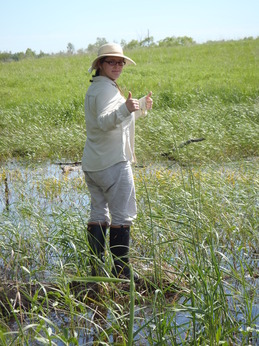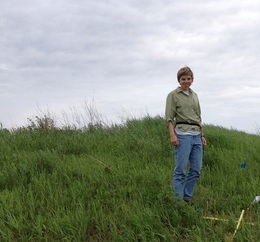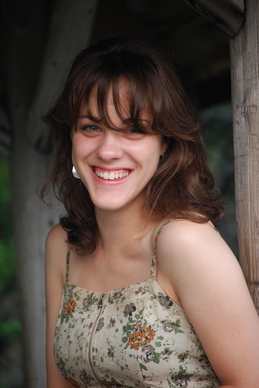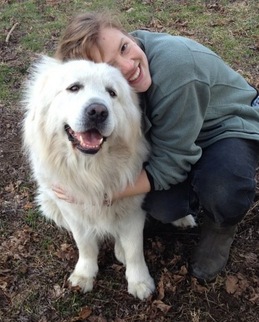|
|
Sara Zufan, aka “Miss Z,” arrived from Chicago, IL (pop > 1 x 10^6 people) to Kensington Minnesota (pop = 280) this weekend and is already hard at work measuring plants and searching for the elusive Stipa grass in the sea of other grasses that is our common garden experiment. Miss Z is teacher in Chicago Public Schools at the Multicultural Academy of Scholarship. Next year she is teaching AP Biology, Regular Biology, and Earth & Space. This summer Miss Z plans to gain some hands-on cutting-edge field biology experience to enhance her professional development as a secondary school science educator. Miss Z is going to figure out how to bring her new knowledge into her classroom this coming school year.
Stay tuned! Miss Z will keep you posted via this blog and twitter on her research endeavors and experiences in the field this summer as she investigates the ecology and evolution of plants and animals in the fragmented tallgrass prairie with the Echinacea Project.
I am a Professor of Biology and Environmental Studies at Gustavus Adolphus College in St. Peter, MN. I just started my year-long sabbatical and it is great to begin it as a member of Team Echinacea! Historically, I always have worked in grasslands, Pacific coastal, Montana and Minnesota sites, so one could say I love prairies.
My research questions focus on processes that generate and maintain diversity in plant populations. This summer Mike, Reina and I will examine three related questions: 1) Do plants from different genetic crosses experience different levels of herbivory? 2) How do morphological and physiological traits such as photosynthetic rate, WUE or leaf area vary as a function of different genetic crosses? 3) What is the feedback between herbivory, physiological traits and genetic identity, and how might this influence plant fitness?
I am originally from Colorado and lived 10 years in California, but I have lived in Minnesota for the past 15 years. I love being outdoors, especially in natural areas where I can hike, canoe, ski, bike, and camp. I also like to garden, read, cook or watch birds (my second favorite avian species with red plumage is the Rose-breasted Grosbeak). Travel to new places, from Kensington to India and beyond, has always given me new perspectives of the world.
 My entry on the website is at: The Echinacea Project People PK My entry on the website is at: The Echinacea Project People PK
Hello, everyone! If you couldn’t tell from the title, I am Sarah Baker. I am a rising Junior at St. Catherine University and an REU intern this summer. I am a biology major with an interest in wildlife and conservation biology. During the academic year, as well as being a student, I work as a teaching assistant for ceramics courses at my school. I will also be working as “animal room technician” this upcoming semester, taking care of organisms used in labs and research for biology related courses.
Anyway, a bit of information about me: I grew up in Golden Valley, Minnesota and spent a lot of time in my childhood and teenage years outdoors. I often went hiking, canoeing, biking, and other types of adventuring outdoors with my family and learned much about nature from those experiences. My father, being a biologist, would often point out various plants and animals to me and identify them, teaching me what they were and interesting facts about them. These excursions fed my interest in wildlife and conservation. In the future, I plan to attend graduate school to study wildlife or conservation biology.
When I’m not doing cool science-y things, I enjoy making pottery, being out in nature, sailing, and hanging with friends. I am also the president of the ceramics club at my school where we host Empty Bowls community service projects to raise money for Minnesota Open Arms.
This summer, my independent project will focus on flowering phenology of various remnants. I will be adding to a data set from 2011 and 2012. My main interest with this project is to see if there are correlations between peak flowering times of the same remnants across multiple years. I look forward to all I will experience this summer!
If you are interesting in learning a bit more about me, check out my webpage on the Echinacea Project website!

Sarah Baker
Hello everyone! I am Kory Kolis and am from Eau Claire Wisconsin. I am a Junior at Gustavus Adolphus College in St. Peter Minnesota (about an hour southwest of the twin cities). I am a biology and studio art double major. Last summer I was doing biochemistry research at Gustavus examining the four proteins that make up the kinetochore of Saccharomyces cerevisiae. I am very excited to be a part of Team Echinacea this summer, and for the opportunity to work outside! Woot!
This summer I plan on continuing the research done by Katie Koch and Andrew Kaul. I will be looking at the efficiency of pollinators on the Echinacea angustifolia. By doing my observations in Jennifer Ison’s common garden I hope to be able to be able to trace the pollen back to the parent plant, allowing me to see if there are any relationships between distance from the two plants and pollinator.
In my free time I love making art. My favorite medium is ceramics, but above all love making sculptures. I recently put on a small show of my artwork in my school library titled “The Alchemist.”
If you would like to see the link of me on the Echinacea Project home page click here.
Hello, flog readers! I am Marie Schaedel, a rising junior at Carleton College. I’m very happy to have gotten the opportunity to study Echinacea and learn about remnant prairie biology this summer. Although native to the congested Chicago region, I am very easily becoming accustomed to Kensington’s sleepy serenity.
This summer, I plan to assess fitness and heritability in the hybrids that Stuart planted earlier this spring. For more specifics about my research question, see my Echinacea Project team member page.
Fun(ish) facts about me:
I have a rabbit named after an Egyptian pharaoh. I play the violin and piano, and am currently learning how to play the ukelele. In my free time, I like to run and lift weights. Winter is my favorite season because I love to cross country ski. This fall, I am traveling to Tanzania to study the biology of traditional agriculture on Mt. Kilimanjaro.
I am looking forward to the rest of the summer! Stay tuned for periodic project updates.

Hello there! My name is Reina Nielsen and I will be a sophomore at Gustavus Adolphus College this fall studying biology. I am excited to be doing research this summer with Dr. Kittleson and Mike. I love being outdoors and can be found fishing, kayaking, canoeing, hiking, or downhill skiing. I am looking forward to an exciting summer!
https://echinaceaproject.org/people/2013-team-members/reina-nielsen-2/
I don’t know if I’ve properly introduced myself on here.
My name is Katherine Muller and I’m a second year Master’s student at Northwestern. I hail from the lovely, temperate San Francisco Bay Area. I’m not sure whether it was my thirst for adventure or my contrarian nature that led me to the Midwest–first to Oberlin College in Ohio, then to Northwestern and Minnesota. In any case, I now have the privilege of complaining about the weather.
This is my second year with the Echinacea Project. Last year I began research on aphids and ants in Echinacea angustifolia. I have two projects that I plan to continue this summer:
My first project is an experiment examining the effects of aphid infestation on Echinacea. Last year, I selected 100 non-flowering Echinacea, excluded aphids from 50 plants and added aphids to the other 50. I am repeating the experiment on the same plants. I performed my first experimental treatments on Saturday and Sunday and should soon be able to analyze my results from last year.
The other project I plan to continue this year is a survey of aphids and ants in a large experimental common garden. Last year I selected a 20x20m section of the experimental plot and led a biweekly of ants and aphids. I started this because I was interested in seeing how aphids spread over space and time. This year I will examine the same area to see how aphid infestation changes from year to year. Thanks to everyone’s help, I collected my first dataset on June 15th. Considering the unusually warm winter, there should be some interesting developments this year.
My third project is to assess aphid and ant abundance among several Echinacea populations. My original plan was to survey aphids and ants on a representative sample of the entire population, including juvenile and non-flowering plants. As it so happens, Amy Dykstra and Daniel Rath conducted a similar survey in 2009 (you can read about it in the archives). For all their hard work, they found very few plants with aphids. Of the plants they surveyed–flowering plants had a much higher rate of aphid infestation than non-flowering plants–32% for flowering versus 5% for non-flowering plants. I decided to take a different approach and focus my sampling effort on flowering plants. Specifically, I will survey aphid and ant abundance on plants that flowered this year and last year. This will allow me to assess whether flowering in one year influences the likelihood of aphid infestation the following year.
That’s about it for now. I’ll be posting my progress on here as it happens. This summer I have the privilege of collaborating with Jill Gall, an REU student from College of the Atlantic. She’s been hard at work preparing her project assessing ant diversity in prairie remnants, which I’ll let her tell you about.
And because everyone else is doing it, here’s a picture:

Hi! I’m Jill and I’m from Sewaren, New Jersey–exit 11 off the turnpike, in the heart of oil refineries and old factories. Sick of the polluted air and lack of wilderness, I fled home for Bar Harbor, Maine to attend College of the Atlantic (COA), a tiny liberal arts school tucked away on the coast of Mount Desert Island. There I study Human Ecology along with every other student– a one-major curriculum allowing every student to independently design his or her own course of study. Entering my senior year this fall, I’ve spent my time at COA studying the relationships between soils, plants, and arthropods on contaminated and other ecologically “harsh” sites–sites distinguished by xeric, nutrient-poor, nutrient-imbalanced soils laced with high levels of heavy metals. I’ll be completing my undergraduate thesis “Diversity and metal content of arthropods on adjacent serpentine and granite outcrops on Deer Isle, ME” this year, hopefully with a manuscript in the works.
Here with The Echinacea Project, I plan to study the ant communities on the prairie remnants and the prairie preserve to provide baseline data for further projects on the ants of the prairie. Like Shona, I’ll post my project proposal on here once it’s polished…
I’m looking forward to the rest of the summer packed with fulfilling fieldwork, great experiences, and wonderful people!


Hello! I’m Kelly. I’m a junior biology major at Carleton College in Northfield, Minnesota. My hometown is St. Louis, Missouri where I live with my parents, an ancient dog and an obnoxious, paper-eating cat. My favorite animal is the beluga whale. I love to hike, bike, and swim. I hope to do some of those things this summer. I have also made it my goal to learn to cook without accidentally burning, breaking, botching or otherwise bungling anything.
I’m really excited to be a part of the Echinacea Project this summer! My first week in Kensington is just now coming to a close. I’ve had a wonderful time and I already feel like I’ve learned a ton about both Echinacea plants and the prairie ecosystem as a whole. For my independent project, I hope to study flowering phenology in several of the remnant populations. There’s a great crew of people here this summer and I can’t wait to meet everyone else who works on the project.

Hi everyone! As Andrew reminded us all a few minutes ago, we were supposed to introduce ourselves this weekend and the weekend is just about over, so here it is.
I’m Shona. I’m a rising Junior at Middlebury College in Vermont, where I’m majoring in biology and grew up on a small organic farm also in Vermont. I’m excited to join the Echinacea Project this year, and to get a taste of what biology research is really like. When I am not crouched in the field doing seedling searches or recruitment surveys, I am planing to focus my independent project on hybridization between Echinacea angustifolia and Echinacea pallida. Someday soon I will post a link to my proposal here, once it is a little bit more polished…
This is the first time I’ve been to Minnesota, and I’m looking forward to exploring and enjoying the beautiful landscape and all of the wildlife (I had no idea that Pelicans lived out here!), and getting to know the rest of the group better. I’ve only been in K town for a week but I can already tell that I’m going to be happy here!
I’m sure I will add on to this more later, but here is my project proposal as it is right now:
echinacea project proposal.pdf
|
|

 My entry on the website is at: The Echinacea Project People PK
My entry on the website is at: The Echinacea Project People PK 




